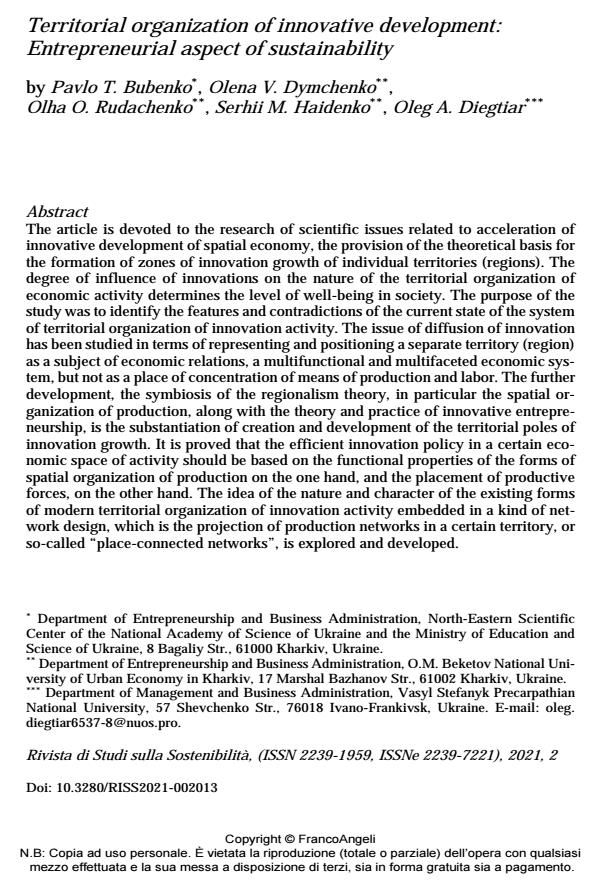Territorial organization of innovative development: Entrepreneurial aspect of sustainability
Journal title RIVISTA DI STUDI SULLA SOSTENIBILITA'
Author/s Pavlo T. Bubenko, Olena V. Dymchenko, Olha O. Rudachenko, Serhii M. Haidenko, Oleg A. Diegtiar
Publishing Year 2022 Issue 2021/2
Language English Pages 15 P. 171-185 File size 126 KB
DOI 10.3280/RISS2021-002013
DOI is like a bar code for intellectual property: to have more infomation
click here
Below, you can see the article first page
If you want to buy this article in PDF format, you can do it, following the instructions to buy download credits

FrancoAngeli is member of Publishers International Linking Association, Inc (PILA), a not-for-profit association which run the CrossRef service enabling links to and from online scholarly content.
The article is devoted to the research of scientific issues related to acceleration of innovative development of spatial economy, the provision of the theoretical basis for the formation of zones of innovation growth of individual territories (regions). The degree of influence of innovations on the nature of the territorial organization of economic activity determines the level of well-being in society. The purpose of the study was to identify the features and contradictions of the current state of the system of territorial organization of innovation activity. The issue of diffusion of innovation has been studied in terms of representing and positioning a separate territory (region) as a subject of economic relations, a multifunctional and multi-faceted economic system, but not as a place of concentration of means of pro-duction and labor. The further development, the symbiosis of the regionalism the-ory, in particular the spatial organization of production, along with the theory and practice of innovative entrepreneurship, is the substantiation of creation and de-velopment of the territorial poles of innovation growth. It is proved that the effi-cient innovation policy in a certain economic space of activity should be based on the functional properties of the forms of spatial organization of production on the one hand, and the placement of productive forces, on the other hand. The idea of the nature and character of the existing forms of modern territorial organization of innovation activity embedded in a kind of network design, which is the projection of production networks in a certain territory, or so-called "place-connected net-works", is explored and developed.
Keywords: region, poles, growth, cluster, competition.
- Metaverse, the last technological frontier of environmental sustainable food: Worldwide evidence from the first business case studies Flavio Boccia, Joanna Rosak-Szyrocka, Houman Hashemzadeh, Daniela Covino, in RIVISTA DI STUDI SULLA SOSTENIBILITA' 1/2023 pp.153
DOI: 10.3280/RISS2023-001009 - Обґрунтування напрямів розвитку інноваційного підприємництва Н. В. Валінкевич, М. О. Рибак, in Проблеми сучасних трансформацій. Серія: економіка та управління /2024
DOI: 10.54929/2786-5738-2024-11-03-12 - ІННОВАЦІЙНЕ УПРАВЛІННЯ ТРУДОВИМ ПОТЕНЦІАЛОМ У СИСТЕМІ ДИДЖИТАЛІЗАЦІЇ ФІНАНСОВО-ЕКОНОМІЧНОЇ БЕЗПЕКИ СМАРТЕКОНОМІКИ Людмила Пронько, Поліна Пузирьова, Віталій Собчишин, Лариса Варава, Денис Захаров, Олена Виноградова, in Financial and credit activity problems of theory and practice /2025 pp.554
DOI: 10.55643/fcaptp.1.60.2025.4694
Pavlo T. Bubenko, Olena V. Dymchenko, Olha O. Rudachenko, Serhii M. Haidenko, Oleg A. Diegtiar, Territorial organization of innovative development: Entrepreneurial aspect of sustainability in "RIVISTA DI STUDI SULLA SOSTENIBILITA'" 2/2021, pp 171-185, DOI: 10.3280/RISS2021-002013